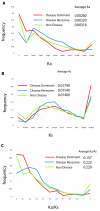Differences in the evolutionary history of disease genes affected by dominant or recessive mutations
- PMID: 16817963
- PMCID: PMC1534034
- DOI: 10.1186/1471-2164-7-165
Differences in the evolutionary history of disease genes affected by dominant or recessive mutations
Abstract
Background: Global analyses of human disease genes by computational methods have yielded important advances in the understanding of human diseases. Generally these studies have treated the group of disease genes uniformly, thus ignoring the type of disease-causing mutations (dominant or recessive). In this report we present a comprehensive study of the evolutionary history of autosomal disease genes separated by mode of inheritance.
Results: We examine differences in protein and coding sequence conservation between dominant and recessive human disease genes. Our analysis shows that disease genes affected by dominant mutations are more conserved than those affected by recessive mutations. This could be a consequence of the fact that recessive mutations remain hidden from selection while heterozygous. Furthermore, we employ functional annotation analysis and investigations into disease severity to support this hypothesis.
Conclusion: This study elucidates important differences between dominantly- and recessively-acting disease genes in terms of protein and DNA sequence conservation, paralogy and essentiality. We propose that the division of disease genes by mode of inheritance will enhance both understanding of the disease process and prediction of candidate disease genes in the future.
Figures



Similar articles
-
Proteins linked to autosomal dominant and autosomal recessive disorders harbor characteristic rare missense mutation distribution patterns.Hum Mol Genet. 2015 Nov 1;24(21):5995-6002. doi: 10.1093/hmg/ddv309. Epub 2015 Aug 5. Hum Mol Genet. 2015. PMID: 26246501 Free PMC article.
-
Human congenital diseases with mixed modes of inheritance have a shortage of recessive disease. A demographic scenario?Ann Hum Genet. 2011 Nov;75(6):688-93. doi: 10.1111/j.1469-1809.2011.00679.x. Epub 2011 Sep 22. Ann Hum Genet. 2011. PMID: 21951014
-
Evolutionary conservation and selection of human disease gene orthologs in the rat and mouse genomes.Genome Biol. 2004;5(7):R47. doi: 10.1186/gb-2004-5-7-r47. Epub 2004 Jun 28. Genome Biol. 2004. PMID: 15239832 Free PMC article.
-
Patterns of genetic inheritance.Neonatal Netw. 1999 Feb;18(1):7-10. doi: 10.1891/0730-0832.18.1.7. Neonatal Netw. 1999. PMID: 10205467 Review.
-
The low frequency of recessive disease: insights from ENU mutagenesis, severity of disease phenotype, GWAS associations, and demography: an analytical review.J Appl Genet. 2014 Aug;55(3):319-27. doi: 10.1007/s13353-014-0203-3. Epub 2014 Mar 21. J Appl Genet. 2014. PMID: 24652618 Review.
Cited by
-
Correlation of microsynteny conservation and disease gene distribution in mammalian genomes.BMC Genomics. 2009 Nov 12;10:521. doi: 10.1186/1471-2164-10-521. BMC Genomics. 2009. PMID: 19909546 Free PMC article.
-
Clinical, agricultural, and evolutionary biology of myostatin: a comparative review.Endocr Rev. 2008 Aug;29(5):513-34. doi: 10.1210/er.2008-0003. Epub 2008 Jun 30. Endocr Rev. 2008. PMID: 18591260 Free PMC article. Review.
-
Prioritization of candidate cancer genes--an aid to oncogenomic studies.Nucleic Acids Res. 2008 Oct;36(18):e115. doi: 10.1093/nar/gkn482. Epub 2008 Aug 18. Nucleic Acids Res. 2008. PMID: 18710882 Free PMC article.
-
A new essential protein discovery method based on the integration of protein-protein interaction and gene expression data.BMC Syst Biol. 2012 Mar 10;6:15. doi: 10.1186/1752-0509-6-15. BMC Syst Biol. 2012. PMID: 22405054 Free PMC article.
-
Overcoming constraints on the detection of recessive selection in human genes from population frequency data.Am J Hum Genet. 2022 Jan 6;109(1):33-49. doi: 10.1016/j.ajhg.2021.12.001. Epub 2021 Dec 23. Am J Hum Genet. 2022. PMID: 34951958 Free PMC article.
References
-
- Huang H, Winter EE, Wang H, Weinstock KG, Xing H, Goodstadt L, Stenson PD, Cooper DN, Smith D, Alba MM, Ponting CP, Fechtel K. Evolutionary conservation and selection of human disease gene orthologs in the rat and mouse genomes. Genome Biol. 2004;5:R47. doi: 10.1186/gb-2004-5-7-r47. - DOI - PMC - PubMed
Publication types
MeSH terms
LinkOut - more resources
Full Text Sources
Medical

